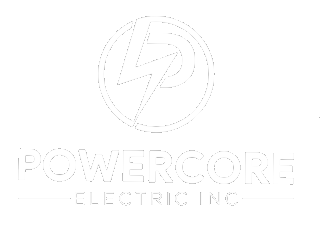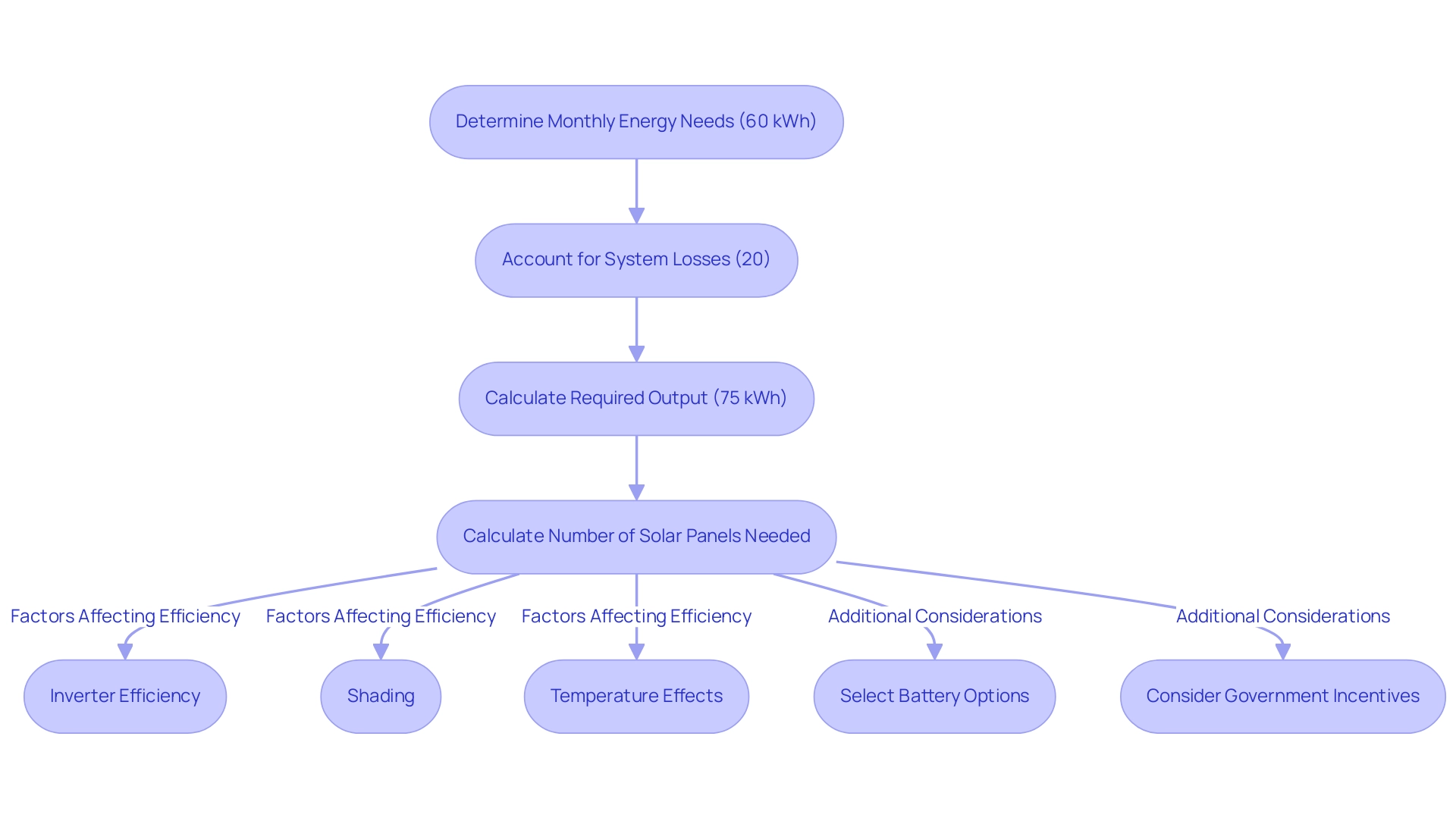Overview
To calculate the number of solar panels needed for your home, start by determining your average monthly power consumption in kilowatt-hours (kWh) and divide your total yearly usage by the average output of a single panel, typically around 300 kWh annually. The article supports this approach by emphasizing the importance of factoring in potential system losses and geographic conditions, which can significantly influence the overall efficiency and output of your solar installation.
Introduction
Navigating the world of solar energy can feel overwhelming, especially for homeowners eager to embrace sustainable living. Understanding how many solar panels are needed to meet energy demands is a crucial first step in this journey. By delving into past electricity usage, assessing future energy needs, and factoring in local conditions, homeowners can make informed decisions that align with their goals.
This guide will break down the essential calculations, explore the factors influencing solar panel requirements, and highlight the importance of accounting for system losses. With the right knowledge and tools, transitioning to solar energy can become a seamless and rewarding experience, paving the way for a greener, more energy-efficient home.
Understanding Your Energy Needs for Solar Panel Calculation
To begin your journey with renewable energy, start by examining your utility bills from the previous year. This will assist you in determining your average monthly power consumption, typically expressed in kilowatt-hours (kWh). For instance, if you find that your monthly usage hovers around 800 kWh, that’s your starting point.
It’s crucial to acknowledge that electricity consumption in homes has increased from 0.25 quads in 1950 to 5.04 quads in 2021, emphasizing the rising power needs that photovoltaic systems can assist with. Next, consider your power aspirations: do you want to cover all your usage or just a portion? This selection will directly affect the number of solar panels needed.
A useful equation to estimate the number of solar panels needed is to take your total yearly power usage and divide it by the average power output of a single photovoltaic module, which is typically about 300 kWh annually. For instance, if your objective is to produce 9,600 kWh each year, just divide that by 300 kWh, and you’ll discover the number of solar panels needed to satisfy your power requirements is roughly 32 units. To demonstrate real-world power consumption, note that Louisiana has the highest yearly usage at 14,774 kWh per household as of 2022, highlighting the significance of precise assessments for photovoltaic requirements.
Additionally, remember that an energy-efficient refrigerator certified by ENERGY STAR® uses an average of 33% less energy than models older than 15 years, showcasing the potential for energy efficiency improvements in households.
When considering solar systems, it’s important to understand how they work. Solar panels transform sunlight into power through photovoltaic cells, which produce direct current (DC) energy. An inverter then converts this DC electricity into alternating current (AC) electricity, which powers your home.
Explore the top battery choices for effective power storage, as they can assist in optimizing your renewable resources by retaining surplus electricity for use during cloudy times. Additionally, consider integrating Tesla home chargers for electric vehicles, which can further enhance your energy efficiency.
Familiarizing yourself with government programs and incentives available in your area, especially for Long Beach renters, can unlock financial assistance and make the transition to renewable energy more accessible. Programs may include rebates for photovoltaic system installation or tax credits that lower the overall cost. Understanding these calculations and resources not only helps you plan effectively but also aligns your home with a sustainable future.
Key Factors Influencing Solar Panel Requirements
When it comes to figuring out the number of solar panels needed for your home, several important factors are involved, and we’re here to assist you in navigating this process. First and foremost, your geographic location is crucial. For instance, areas that bask in abundant sunlight will typically require fewer panels to achieve the same power output compared to those in cloudier regions.
It’s intriguing to observe that worldwide photovoltaic electricity production increased from merely 0.4 billion kWh in 1990 to approximately 1,280 billion kWh in 2022, with China and the United States at the forefront, generating about half of the globe’s renewable power. This emphasizes the significance of sunlight availability in maximizing solar efficiency and the increasing potential of solar power for homeowners like you.
Next, let’s talk about your roof. The orientation and angle of your roof can significantly affect how much sunlight your devices will capture. In the Northern Hemisphere, south-facing roofs are the champions, soaking up the most sunlight and thereby maximizing energy production.
If your roof is slanted differently, or if it’s obstructed by trees or nearby structures, this could hinder sunlight access, decreasing the efficiency of your system. As a general guideline, a 20% rise in humidity can cause a decrease of roughly 3.16 watts in power capacity for your systems, making it crucial to consider local climate conditions. This connection between humidity and efficiency illustrates the significance of understanding your local environment.
Don’t forget to consider your future power requirements! If you anticipate incorporating electric vehicles or bigger appliances into your home, it’s prudent to consider these possible rises in power usage when calculating the number of solar panels needed. A recent study comparing photovoltaic (PV) systems at various elevations revealed that taller systems generated considerably more power, highlighting how geographic elements can affect output.
The PV system in Semendo Darat Ulu, located at 1100 meters above sea level, generated an average of 343.88 watts per day—129% more than its counterpart in a lower elevation. This serves as a great reminder that location is everything when it comes to renewable energy! Furthermore, examining creative approaches, like combining a Solar Power Plant with a Hydro Power Plant, could offer additional advantages for residential communities such as Tanjung Raja Village.
Notably, numerous homeowners have experienced significant reductions in their utility costs after implementing photovoltaic systems, with some even attaining self-sufficiency in power. For instance, a household in California decreased their monthly electricity expenses by more than 50% after transitioning to photovoltaic power. By understanding these elements, you can make a well-informed decision about your energy system and embrace a sustainable, energy-independent lifestyle.
To begin your renewable energy journey, don’t hesitate to request your free personalized estimate today!
Calculating Solar Panel Output
Determining the output of your photovoltaic systems is a simple yet essential process that centers on two key factors: the device’s wattage and the average sunlight hours your region receives. This user manual will guide you through these calculations. For instance, if you have a 300-watt photovoltaic panel and your location enjoys about 5 hours of sunlight each day, the daily output would be calculated as follows:
- 300 watts multiplied by 5 hours results in 1,500 watt-hours, or 1.5 kWh.
Over the course of a month, this adds up to approximately 45 kWh (1.5 kWh multiplied by 30 days). Furthermore, a 5-kilowatt photovoltaic system should produce approximately 5 kilowatt-hours, offering a valuable benchmark for homeowners to contemplate.
Comprehending local peak sun hours is essential for establishing realistic expectations for your renewable power generation. Even in areas with fewer sunny days, advancements in photovoltaic technology, including the integration of efficient battery storage, can yield impressive results. As Ifeoluwa Daniel reminds us, ‘Remember, sunlight power isn’t solely for the typically bright states; advancements in technology and strategic planning can make sunlight feasible in less bright areas as well.’.
To maximize the benefits of your solar investment, consider storing excess electricity generated by your system and leveraging net metering to offset utility bills. For optimal power storage, consider battery options such as:
- lithium-ion batteries, which offer high efficiency and longevity,
- lead-acid batteries, which are more affordable but less efficient.
By combining the total production from all your units, you can effectively contrast this with the number of solar panels needed for your monthly power usage.
This evaluation is crucial in guaranteeing you’re on course to satisfy your power requirements and to calculate the number of solar panels needed to enhance the advantages of your investment in renewable technology. Additionally, comprehending local peak sun hours, as emphasized in the case study titled ‘Realistic Expectations for Solar Investments,’ assists in establishing practical expectations for photovoltaic production and informs choices in selecting the optimal inverters and battery options for your home.
Considering System Losses
When determining the number of solar panels needed for your home, it’s crucial to consider potential system losses, which can range from 15% to 25%. These losses can arise from various factors such as inverter inefficiency, shading from trees or buildings, and temperature effects. For instance, if you calculate that you need about 60 kWh of power each month, accounting for a typical 20% loss means you should aim for an actual output of 75 kWh, which can help you determine the number of solar panels needed by dividing 60 kWh by 0.8.
This adjustment not only prepares you for less-than-ideal conditions but also ensures you have sufficient capacity to meet your power needs reliably. Comprehending the effect of inverter efficiency on your photovoltaic output is crucial, as it greatly affects the overall performance of your system. Furthermore, as emphasized by Dr. Mark Z. Jacobson, Director of the Atmosphere/Energy Program at Stanford University:
- “The best overall strategy for a homeowner in terms of saving substantial amounts of money over the long term, reducing air pollution in your residence, and generating your own electricity and heat during a blackout is to electrify everything in your home and supply the electricity with photovoltaic systems and store the electricity in a battery.”
Selecting the appropriate battery choices, such as the Tesla Powerwall, LG Chem RESU, or Sonnen Eco, is essential for effective power storage and management, ensuring that you can depend on your system during peak periods or outages. Additionally, with 85% of installers using NREL’s SolarAPP+ reporting that it makes permitting significantly easier, you can feel more confident in navigating the installation process. Furthermore, government programs such as the Federal Investment Tax Credit (ITC) can provide substantial savings on your renewable energy investment, while Tesla home chargers facilitate the integration of electric vehicles with your energy setup.
By being attentive to these elements and understandings, including the advantages of expert cleaning of photovoltaic modules—which can improve efficiency and prolong the lifespan of your system—you can make a knowledgeable choice that optimizes your investment in renewable resources.
Finalizing Your Solar Panel Calculation
After assessing your power needs and the factors affecting your solar module requirements, it’s time to determine the number of solar panels needed. This entails collecting crucial information, such as your total yearly power usage, the anticipated output from each module, and required modifications for system losses. For example, if your calculations indicate a need for 32 units based on your energy usage, but adjustments for potential losses suggest aiming for 38 units to ensure adequate energy output, the final count of the number of solar panels needed becomes crucial.
Remember, the space occupied by photovoltaic modules can be calculated as:
- area occupied = required units × module width × module length,
where width and length are measured in meters. This considerate strategy not only assists you in acquiring the appropriate quantity of modules but also enables you to make knowledgeable choices regarding your energy system. As Alex S., co-founder of Shop Solar, states, “With a passion for innovation and sustainable power, we’re committed to making this technology accessible for everyone.” Furthermore, it’s crucial to ensure that your calculated output meets or exceeds your total consumption, confirming the sufficiency of your system.
Routine upkeep of your units is crucial for optimal performance; dirty or shaded surfaces can significantly reduce energy production. Staying abreast of the latest market trends can also improve your purchasing decisions. For example, SUNWAY Technology is presently arranging a worldwide tour in October to promote green technology, highlighting the growing momentum in the renewable energy sector.
Moreover, comprehending the expenses linked to photovoltaic panels compared to conventional power is essential. Homeowners should consider not only the initial investment but also the long-term savings on electricity bills. Studies indicate that although the initial expense of installation can be considerable, it frequently recoups its costs within a few years through decreased utility expenses.
Furthermore, choosing the appropriate battery is crucial for effective power storage. Options such as lithium-ion batteries are popular due to their longevity and efficiency, allowing homeowners to store excess energy generated during the day for use during peak hours or at night. By remaining informed and proactive, you can make your solar investment both efficient and effective.
Conclusion
Understanding how many solar panels are needed to meet energy demands is a pivotal step for homeowners looking to embrace a sustainable lifestyle. By taking a close look at past electricity usage, future energy needs, and local conditions, individuals can make informed decisions about their solar investments. The calculations outlined in this guide, from assessing energy consumption to accounting for system losses, provide essential insights that simplify the transition to solar energy.
As highlighted, factors such as geographic location, roof orientation, and potential future energy usage play significant roles in determining the number of panels required. Homeowners can maximize their solar energy production by considering these elements alongside system losses and technological advancements. Engaging with local incentives and understanding the financial aspects of solar energy further enhance the feasibility of this green investment.
Ultimately, transitioning to solar energy is not just about installing panels; it’s about creating a sustainable and energy-efficient home that aligns with personal values and future aspirations. By equipping themselves with knowledge and resources, homeowners can confidently navigate the solar landscape, paving the way for a cleaner, greener future.



